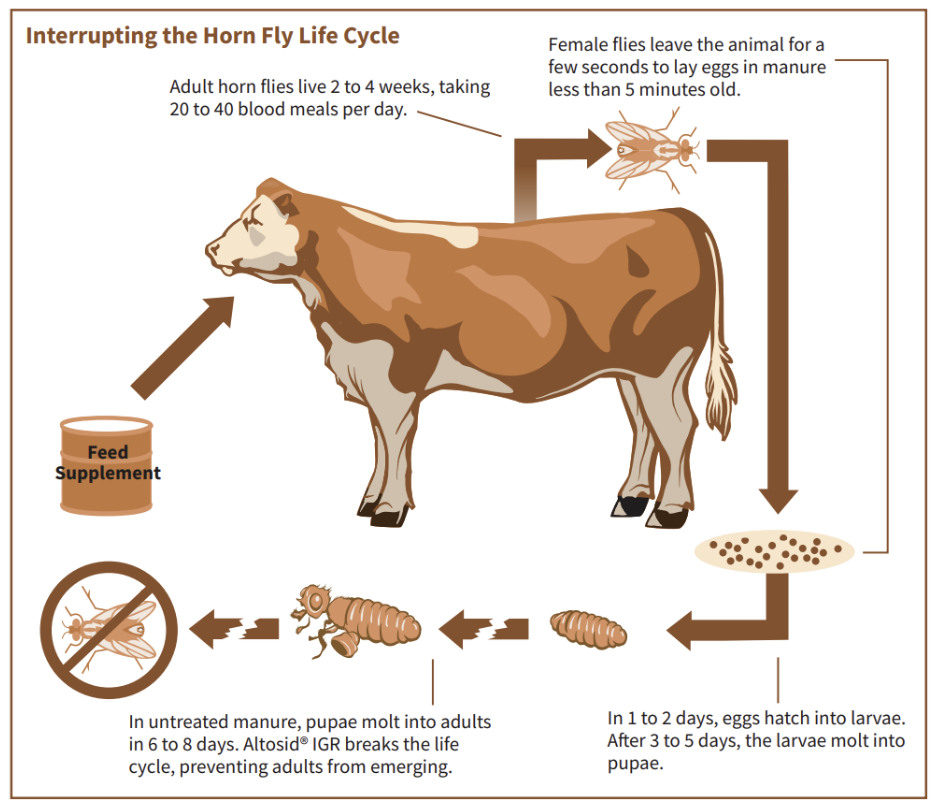Horn flies pose a significant threat to cattle herds across North America, causing substantial economic losses through reduced weight gains, decreased feed efficiency, and lower milk production. These losses not only impact profitability but also affect overall cattle health and productivity. In this blog, we delve into the economic benefits of fly control when using Altosid® IGR (Insect Growth Regulator) for effective horn fly control.
Calculating the Economic Impact of Horn Flies on Cattle Herds
Horn flies are relentless bloodsucking parasites that can significantly impact cattle productivity. Studies estimate that horn flies cost the North American cattle industry over $1 billion annually due to reduced weight gains and milk yields. The economic threshold for horn fly infestation, where control measures become cost-effective, is typically around 200 flies per animal. Beyond this threshold, the cost of production losses outweighs the expense of implementing control strategies.
ROI Analysis for Cow/Calf and Stocker Cattle Operations
For cow/calf and stocker cattle operations, the impact of horn flies can be profound. Studies have shown that stocker cattle can experience up to a 14% reduction in average daily gain during a 120-day fly season. This reduction translates to tangible losses in weight gain and overall herd profitability. Implementing Altosid® IGR in a comprehensive fly control program not only mitigates these losses but also provides a measurable return on investment (ROI).
To calculate Altosid® IGR ROI, consider the following:
Figure the value of stocker cattle weight loss due to horn flies
A. Fill in your average stocker weight per head at season end…… **____**lbs.
B. Potential weight loss per head per season…… 0.14 x A = **____**lbs.
C. Fill in the total number of head in your stocker cattle herd…… ____
D. Potential weight loss per season for your herd…… B**____** x C**____** = **____**lbs.
E. Fill in the sale price of stocker cattle in $/hundredweight…… $____
F. Total value of herd weight loss…… 0.01 x D**____** x E**____** = $____
Figuring the return from using Altosid® IGR
G. Number of cows in your herd (from line C)…… ____
H. Herd cost per day to use Altosid® IGR…… 0.04 x G**____** = $____
(Average cost of Altosid® IGR is 3 to 5 cents per head per day)
I. Altosid® IGR horn fly control program cost per 120-day fly season……120 x H**____** = $____
J. Return on investment in Altosid® IGR per season…… F - I**____** = $____
Net herd season savings…… ____
Case Studies and Field Trial Results
Field trials and case studies across various states have consistently demonstrated the effectiveness of Altosid® IGR in controlling horn fly populations.
For instance:
- In Illinois, cattle fed with 0.02% Altosid® IGR saw a remarkable 95% reduction in horn fly counts compared to untreated herds. This highlights significant horn fly control cost savings.
- Similar results were observed in Kentucky, South Carolina, and Texas, where Altosid® IGR effectively suppressed horn fly development, keeping populations below the economic threshold. This shows the economic benefits of fly control using Altosid® IGR.
These studies underscore the reliability and efficacy of Altosid® IGR in maintaining optimal cattle health and productivity throughout the fly season, ultimately improving Altosid® IGR cattle productivity.
Altosid® IGR offers more than just effective horn fly control—it provides a strategic advantage in enhancing cattle productivity and profitability. By reducing economic losses associated with horn fly infestations, Altosid® IGR enables producers to optimize weight gains, improve feed efficiency, and sustain higher milk yields. Investing in Altosid® IGR is not just a cost-effective choice but a proactive measure towards ensuring the long-term health and performance of cattle herds.
Incorporating Altosid® IGR into your fly control strategy isn't just about reducing pest populations; it's about maximizing your herd's potential and profitability.


